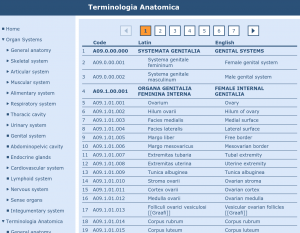An analysis of medical terminology in the international index, Terminologia Anatomica (illustrated below), reflects linguistic gender bias in the field of biology.
Under Genital Systems in the Terminologia Anatomica, the “female” section has 134 specific terms while the “male” section lists over 10% more (153 terms). This may simply indicate that female anatomy is less complex than male anatomy, but further exploration points to a different conclusion.
The clitoris and the penis are similar organs that develop from the same embryonic structure. One might suppose that these structures would have similar numbers of terms to describe them, but that is not the case in the Terminologia. In fact, 362% more terms describe the penis (29) than the clitoris (8).

Further, the index is missing a structure from the list of female genital terms: the Skene’s gland, also known as the female prostate. The male section includes the prostate, but the female section does not, despite its existence in the female body. In fact every human body has a prostate, not just males. The Terminologia Anatomica does not reflect this important information.
What causes these discrepancies? The answer is a consequence of who did the naming. The terms describing the penis reflect a markedly more detail-oriented approach than the approach taken when examining the clitoris. We know a historic gender bias exists in biological science, and this difference in depth of specificity and detail may be a consequence of whose eyes have done the science: white men have always dominated the study of this subject. This historical imbalance will continue to affect the study of biology because men and male research still dominate the field.
Image:
https://steemit.com/science/@getonthetrain/5-leonardo-da-vinci-anatomy-of-man